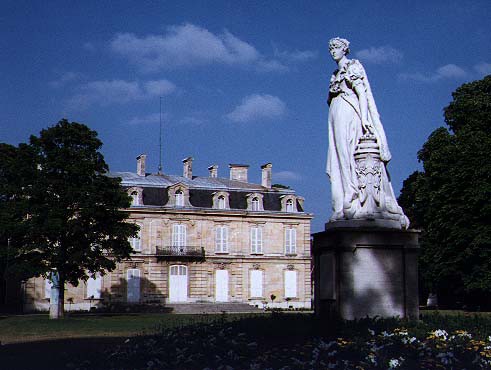The Bois-Préau Château is situated in the midst of a landscaped park of over 42 acres which used to be part of the Malmaison estate and was bought by Josephine in 1810. Indeed she used it as an annex for Malmaison in order to accommodate both her doctor and guests. Rebuilt in 1855, the subsequent owners Mr. and Mrs. Tuck-Stell gave it to the State in 1929. It was opened in 1958 as a museum devoted to Napoleon's captivity and death on Saint-Helena Island, the Return of Napoleon's body and the Napoleonic legend.
Visitors to the park are first confronted with a statue of Josephine by Vital-Dubray before entering the hall of the museum where there are six busts of Napoleon by Eugène Guillaume and a large statue of the Emperor on his death-bed by Vincenzo Vela.
The first floor deals with the Emperor's journey into exile on board the Bellérophon, and his subsequent captivity on the island of St. Helena spent at The Briars and Longwood. The second room is a reconstruction of his death-chamber and contains items relating to his son, the King of Rome. The next room traces the Emperor's various activities on the island and gives a presentation of his companions, Count Marchand, General Baron Gourgaud to whom Napoleon dictated his Mémoires, General Bertrand, Las Cases (the author of the famous Souvenirs), and Antommarchi, the doctor who carried out the Emperor's autopsy.
The fourth room contains a display of the Emperor's personal belongings: his clothes, his travel luggage decorated by Biennais, crockery, etc. The last two rooms are devoted to the Emperor's death and his tomb. A painting dating from 1843 portraying him on his death bed, and facing the picture there is a display case in which the crucifix seen in the painting is placed above the original plaster cast of Napoleon's death-mask. In addition there are some reliquaries composed after the Emperor's death. These both bear witness to the cult that had begun to develop at the time, and also give a foretaste of the second part of the visit.
The second part, centred on the imperial legend, starts on the ground floor. Bonaparte, who used image propaganda as early as the Consulate period, is the central figure of the many allegories on show. Fierce British satirical cartoons suggest a somewhat less grandiloquent vision of his character. Official representation of the Emperor developed to such an extent that sacred views such as Vernet's print of “Napoleon coming out from his grave” became frequent. Other items record the secret struggle of Bonapartists during the Restoration before their cult became public in 1821. Louis-Philippe was later to encourage the cult with his policy of appeasement. The return of Napoleon's body in 1840 on board the Belle Poule is shown in the painting by Philippoteaux, “Landing in Courbevoie”. The last room takes as its theme the “officialising” of Napoleon's memory during the Second Empire and the survival of the legend to this day.
Trans. P.H.
Bois-Préau National Museum


